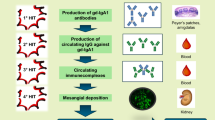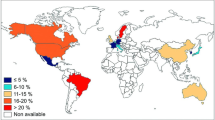Abstract
In this study, we investigated soluble tumor necrosis factor receptor (sTNF-R) levels in plasma of patients with either a kidney or cardiac allograft when clinical suspicion of acute rejection was raised. In plasma of patients with acute renal graft rejection, the sTNF-R levels were strongly enhanced (20–150 ng/ml) as compared to plasma of patients with stable renal function. Following successful treatment of the rejection, a gradual decline in sTNF-R levels occurred with improving renal function, and an inverse correlation between creatinine clearance and sTNF-R was found. To determine whether the increase was caused by an accumulation of constitutively released sTNF-R and lack of clearance by the kidney, or whether the immunological process of the rejection caused the enhancement, we measured sTNF-R in patients suffering from acute cardiac graft rejection but with predominantly stable kidney function. Rejection of a cardiac graft did not lead to a significant enhancement of sTNF-R levels. However, treatment with ATG or OKT3 did cause enhanced sTNF-R levels, followed by a decline that reached starting values after 7 days. These results provide evidence that the immune reaction that occurs during rejection of a graft does not per se induce discernible changes in sTNF-R levels, whereas that induced by ATG or OKT3 does. Thus, sTNF-R levels are not a reliable marker in transplant recipient monitoring.
Similar content being viewed by others
References
Abramowicz D, Schandene L, Goldman M, Crusiaux A, Vereerstraeten P, De Pauw L, Wybran J, Kinnaert P, Dupont E, Toussaint C (1989) Release of tumor necrosis factor, interleukin-2, and gamma-interferon in serum after injection of OKT3 monoclonal antibody in kidney transplant recipients. Transplantation 47: 606–608
Aderka D, Engelmann H, Maor Y, Brakebusch C, Wallach D (1992) Stabilization of the bioactivity of tumor necrosis factor by its soluble receptors. J Exp Med 175: 323–329
Bemelmans MHA, Gouma DJ, Buurman WA (1993) Influence of nephrectomy on tumor necrosis factor clearance in a murine model. J Immunol 150: 2007–2017
Bemelmans MHA, Abramowicz D, Gouma DJ, Goldman M, Buurman WA (1994) In vivo T-cell activation by anti-CD3 mAb induces soluble TNF receptor release in mice: effects of pentoxifylline, methylprednisolone, anti-TNF and anti-IFN-γ antibodies. J Immunol 151: 5554–5562
Billingham ME, Cary NAB, Hammond ME, Kemnitz J, Marboe C, McCallister HA, Snovar DC, Winters GL, Zerbe A (1990) A working formulation for the standardisation of nomenclature in the diagnosis of heart and lung rejection: Heart Rejection Study Group. J Heart Transplant 9: 587–593
Brockhaus M, Bar-Khayim Y, Gurwicz S, Frensdorff A, Haran N (1992) Plasma tumor necrosis factor soluble receptors in chronic renal failure. Kidney Int 42: 663–667
Chatenoud L, Ferran C, Legendre C, Thouard I, Merite S, Reuter A, Gavaert Y, Kreis H, Franchimont P, Bach JF (1990) In vivo cell activation following OKT3 administration. Transplatation 49:697–702
Dallman MJ, Clark GJ (1991) Cytokines and their receptors in transplantation. Curr Opin Immunol 3: 729–734
Debets JMH, Leunissen KML, Hooff JP van, Linden CJ van der, Buurman WA (1989) Evidence of involvement of tumor necrosis factor in adverse reactions during treatment of kidney allograft rejection with antithymocyte globulin. Transplantation 47: 487–492
De Groote G, Grau GE, Dehart I, Franchimont P (1993) Stabilisation of functional tumor necrosis factor-α by its soluble TNF receptors. Eur Cytokine Netw 4: 359
Ding A, Porteu F (1992) Regulation of tumor necrosis factor receptors on phagocytes. Proc Soc Exp Biol Med 200: 458–465
Engllberts I, Stephens S, Francot GJM, Linden CJ van der, Buurman WA (1991) Evidence for different effects of soluble TNF-receptors on various TNF measurements in human biological fluids. Lancet 338: 515–516
Engelmann H, Novick D, Wallach D (1990) Two tumor necrosis factor-binding proteins purified from human urine. J Biol Chem 265: 1531–1536
Froon AHM, Bemelmans MHA, Greve JW, Linden CJ van der, Buurman WA (1994) Increased plasma levels of soluble tumor necrosis factor receptors in sepsis syndrome: correlation with plasma creatinine. Crit Care Med 22: 803–809
Heilig B, Wermann M, Gallati H, Brockhaus M, Berke B, Egen O, Pezzuto A, Hunstein W (1992) Elevated TNF receptor plasma concentrations in patients with rheumatoid arthritis. Clin Invest 70: 22–27
Jutte NHPM, Hesse CJ, Balk AHMM, Mochtar B, Weimar W (1990) Sequential measurements of soluble interleukin 2 receptor levels in plasma of heart transplant recipients. Transplantation 50: 328–330
Lantz M, Malik S, Slevin ML, Olsson I (1990) Infusion of tumor necrosis factor (TNF) causes an increase in circulating TNF-binding protein in humans. Cytokine 2: 402–406
Lantz M, Thysell H, Nilsson EO, Olsson I (1991) On the binding of tumor necrosis factor (TNF) to heparin and the release in vivo of the TNF-binding protein I by heparin. J Clin Invest 88: 2026–2031
Leeuwenberg JFM, Denterner MA, Buurman WA (1994) LPS-mediated soluble TNF receptor release and TNF receptor expression by monocytes. J Immunol 152: 5070–5076
Leeuwenberg JFM, Jeunhomme TMAA, Buurman WA (1994) Slow release of soluble TNF receptors by monocytes in vitro. J Immunol 152: 4036–4043
Leeuwenberg JFM, Mat O, Abramowicz D, Gastaldello R, Tielemans C, Buurman WA (1994) Increased plasma levels of soluble tumor necrosis factor-receptors in uraemic patients: effects of dialysis, type of membrane, and anticoagulation method. Nephrol Dial Transplant 9: 1125–1129
Maury C, Maury J, Teppo A-M (1987) Raised serum levels of cachectin/tumor necrosis factor α in renal allograft rejection. J Exp Med 166: 1132–1137
McLaughlin PJ, Aikawa A, Davies HM, Ward RG, Bakran A, Sells RA, Johnson PM (1991) Evaluation of sequential plasma and urinary tumor necrosis factor alpha (TNF) levels in renal allograft recipients. Transplantation 51: 1225–1229
Myers BD, Newton L (1991) Cyclosporine-induced chronic nephropathy: an obliterative microvascular injury. J Am Soc Nephrol 2: S45-S52
Peetr C, Thysell H, Grub A, Olsson I (1988) A tumor necrosis factor binding protein is present in human biological fluids. Eur J Haematol 41: 414–419
Spinas G, Keller U, Brockhaus M (1992) Release of soluble receptors for tumor necrosis factor (TNF) in relation to circulating TNF during experimental endotoxinemia. J Clin Invest 90: 533–536
Stockenhuber F, Kramer G, Schenn G, Pec M, Keil M, Gnant M, Steininger R, Balcke P, Mühlbacher F (1993) Circulating ICAM-1: novel parameter of renal graft rejection. Transplant Proc 25: 919–920
Tartaglia L, Goeddel D (1992) Two TNF receptors. Immunol Today 13: 151–153
Trochu JN, Denis M, Auget JL, Giral M, Jacques Y, Soulillou JP, Le Mauff B (1992) Soluble interleukin 2 receptor (Tac chain) is not a reliable marker in kidney transplant recipient monitoring. Transpl Int 5: 145–150
Tsuchida A, Salem H, Thomson N, Hancock WW (1992) Tumor necrosis factor production during human renal allograft rejection is associated with depression of plasma protein C and free protein S levels and decreased intragraft thrombomodulin expression. J Exp Med 175: 81–90
Van Zee K, Kohno T, Fischer E, Rock CS, Moldawer LL, Lowry SF (1992) Tumor necrosis factor soluble receptors circulate during experimental and clinical inflammation and can protect against excessive tumor necrosis factor α in vitro and in vivo. Proc Natl Acad Sci USA 89: 4845–4849
Zietse R, Balk AH, Dorpel MA van de, Meeter K, Bos E, Weimar W (1994) Time course of the decline in renal function in cyclosporine-treated heart transplant recipients. Am J Nephrol 14: 1–5
Author information
Authors and Affiliations
About this article
Cite this article
Leeuwenberg, J.F.M., Froon, A.H.M., Vaessen, L.M.B. et al. Soluble tumor necrosis factor-receptors are not a useful marker of acute allograft rejection: a study in patients with renal or cardiac allografts. Transpl Int 8, 459–465 (1995). https://doi.org/10.1007/BF00335598
Received:
Revised:
Accepted:
Issue Date:
DOI: https://doi.org/10.1007/BF00335598




